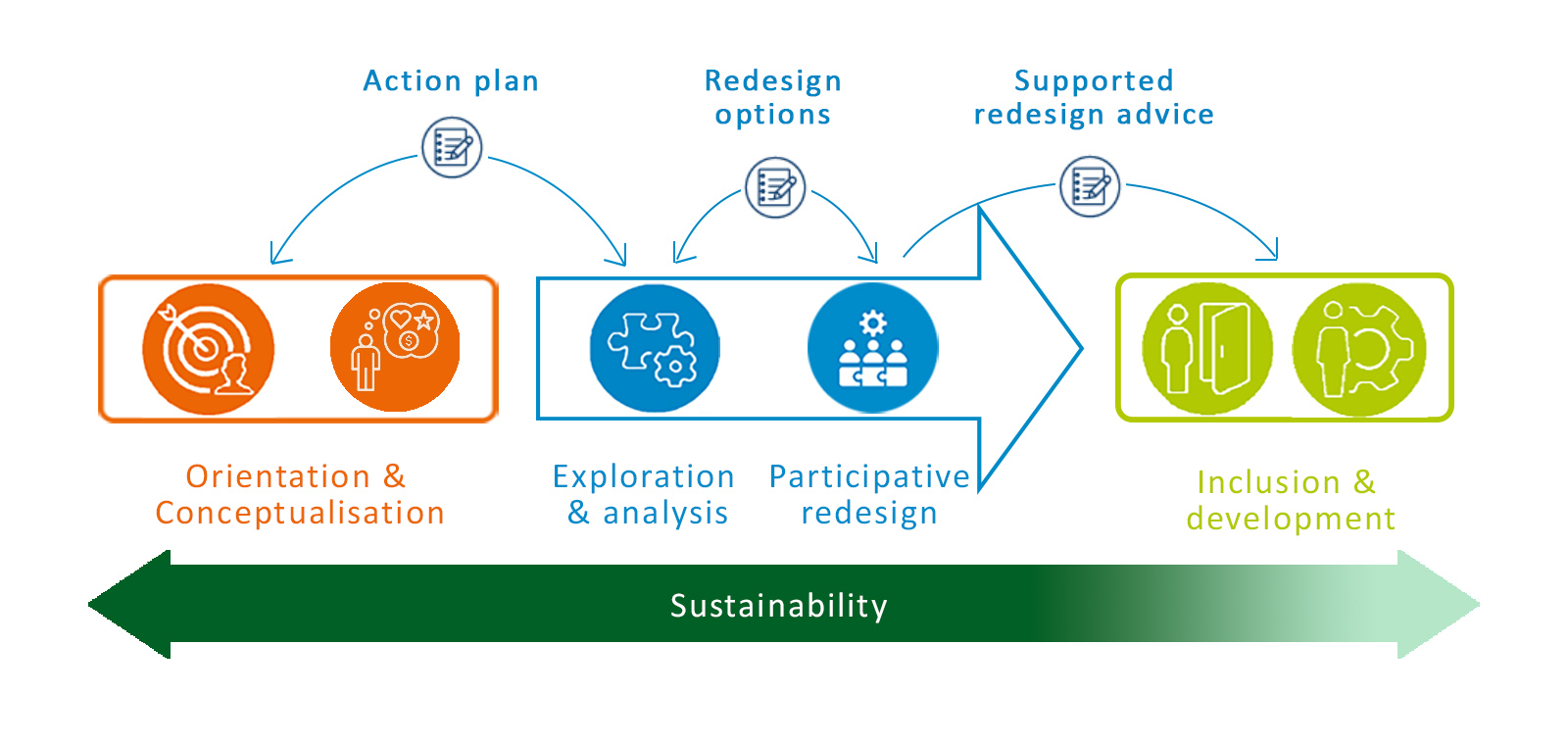- About us
- Inclusive organisation
- Methods & instruments
- Sharing Knowledge
- CONTACT
Putting IWR 2.0 into practice takes place over five phases: orientation, conceptualisation, exploration & analysis, participative redesign and development & inclusion. Increasing sustainability is an important foundation for sustainable inclusion, at which these five phases aim. The diagram below visualises the different phases and their provisional foundation.

|
|
Oriëntation |
During the preparatory Orientation phase, information is gathered.
Performing a labour market analysis provides insight into personnel demand and supply, as well as background information on both sector and organisational levels.
|
|
Conceptualisation |
During the Conceptualisation phase, personnel challenges the organisation faces or may face in the future due to internal and external developments are explored. The organisation’s wishes and needs are also mapped out. In collaboration with a delegation of the organisation, various types of solutions are explored and then translated into a concrete advice. If IWR might be of value to the organisation, this advice should also contain a suitable plan of action for exploring the possibilities and conditions of organising inclusively.
|
|
Exploration & analysis |
When the organisation agrees with the plan of action and is willing to commit to it, the Exploration & analysis phase follows. During this phase, current and future work, the context in which the work takes place, and corresponding demands and qualifications are mapped out. Perspectives held within the organisation concerning working differently will also be explored. Meaningful connection will be sought in order to help the organisation develop into a sustainably inclusive organisation. This phase concludes with a report describing this phase’s insights clearly and concisely.
If the exploration shows enough potential, leads and support for organising inclusively and sustainably, work redesign will be outlined and advice for follow-up steps is provided.
|
|
Participative redesign |
This phase explores, in a participative manner, how work may be organised in such a way that current and new employees are able to work together in a sustainable and meaningful way, while at the same time guaranteeing continued quality of service.
At the end of this phase, a report containing conditions for sustainable embedment will be written.
|
|
Inclusion & development |
Inclusion refers to an HRM policy that guarantees specific groups’ sustainable inclusion. In such a policy, attention is paid to suitable guidance towards employment and suitable work, as well as to methodical coaching, in order to support the process of development and learning of people who are unable to participate independently in the current labour market.
|
|
Increasing sustainability |
IWR 2.0’s goal is organising inclusively in a sustainable way, so that both current and new employees are able to work (together) in a sustainable and meaningful way, while at the same time guaranteeing continued quality of work and service. Increasing sustainability covers two separate matters: sustainable employability and permanent embedment of workplace inclusion.
For this reason, the added value of organising inclusively takes a central spot during the entire process. The participative approach helps to realise this, as it achieves optimal involvement and ownership on behalf of the permanent embedment of inclusion within the organisation.
In the Netherlands, it is difficult to fill vacancies for medical lab technicians. Moreover, a high outflow of personnel due to retirement is expected within the next five years. During this project, we’ve explored the possibilities for an efficient and structural redesign of work, in order to guarantee and optimise quality of work and care, and to allow both current technicians and (re-)integrating employees to function in an optimal and sustainable manner. Through interviews and participative work meetings, we increased awareness of the broader staffing problem. This provided insight into task execution and opportunities for task distribution. We also tried to stimulate acceptance of the added value of work redesign. Redesign of work has enabled lab technicians to perform their core tasks in a more efficient way. New personnel has been hired to help out with examinations and logistic tasks and the new job of fulltime scheduler has been created. Positive consequences of this project are reduced work pressure and absenteeism, more time for supervision and coaching of student lab technicians and interns, and more room for leave or vacation.